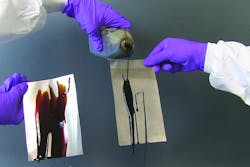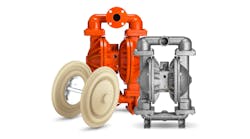Viscous liquids are a nuisance for many people across processing industries. They create cleanup headaches, clog pipes, increase the need for harsh chemicals, expand carbon footprints and create copious amounts of waste in general. Regardless of what is being processed — be it chemicals, food ingredients, healthcare products or paint — sticky materials cause major problems for manufacturers.
Recent scientific advancements have uncovered innovative solutions for processing such sticky liquids, and while these new solutions may seem simple at first glance, they ultimately enable greater manufacturing flexibility.
Scholars started their initial research into these coatings as they were looking for solutions to classic sticky problems such as ice formation on airplane wings, hydrate buildup within oil and gas pipelines, and inadequate product evacuation from everyday consumer packaging.
To solve these problems, scientists looked to natural superhydrophobic surfaces that repel liquids, such as a lotus leaf repelling water droplets. They found that surfaces with certain chemistries and roughness possess strong non-wetting properties, specifically because of diminished contact between the liquid and the surface caused by trapped air pockets in the texture. As long as these air pockets remain stable, the surface maintains its non-wetting characteristics. However, maintaining the stability of the air pockets is challenging because they can collapse under pressure, and liquids with low surface tension can displace the trapped air. Also, if the surface gets damaged, the non-wetting effect is lost.
As research continued to look for slippery solutions, scientists attempted to achieve similar results by impregnating lubricating liquids within surface structure instead of trapping air. Like the way oil in a frying pan keeps eggs from sticking to the hot surface, liquid-impregnated surfaces enable droplets of viscous liquids to move with remarkable ease, except that the trapped lubricants do not run off the surface like they would in the frying pan example. Recent studies have demonstrated that such non-wetting surfaces cannot only repel a variety of liquids, but they can also reduce crystal formations and enhance condensation. They also demonstrate self-healing properties as a result of capillary wicking.
Massachusetts Institute of Technology (MIT) scientists who conducted the research examined the physicochemical hydrodynamics and contact line morphology of liquid-impregnated surfaces when droplets were placed on and moved across them. They also studied the droplets’ initial resistance to movement as well as viscous dissipation and sliding velocity. This research led to the creation of a thermodynamic model and methodology for creating permanently wet slippery surfaces. The MIT scientists applied this methodology to address a persistent consumer problem, and the team’s ketchup bottle video went viral shortly after they won the MassChallenge Competition and the Audience Choice Award at the MIT $100K Entrepreneurship Competition in 2012.
Visually, the ketchup bottle video appears to be similar to videos of traditional superhydrophobic coatings, but those coatings are made from polymers that are not safe for many applications such as food and health and beauty products. What makes liquid-impregnated slippery coatings unique is that the methodology for their design allows for the creation of customized coatings with properties that address the needs of specific applications. Those properties include immiscibility, heat resistance, corrosion resistance and edibility.
Because the liquid-impregnated coating methodology is a blueprint for the physics of the coatings, it enables the development of custom coating recipes that can be developed from a list of hundreds of different materials, including food ingredients. Each coating does not repel all viscous liquids, but is instead designed for a specific one. What works for one particular application does not necessarily work for another, but because of the technology’s flexibility, a large number of potential applications exists.
Consumer implications
The next step for the researchers was to identify commercial applications for the intellectual property they had developed. The consumer packaged goods (CPG) space was one of the first arenas that came to mind. Consumers have always struggled with viscous liquids such as condiments, glue and paint, and the potential benefits of slippery coatings for consumer products were obvious. Primarily, they represented a way to reduce waste and improve customer satisfaction.
In 2009, Consumer Reports conducted a study of viscous liquids that remain trapped in their packaging. According to that research, 17 to 25 percent of skin lotion, 7 to 16 percent of laundry detergent, 3 to 15 percent of condiments and 1 to 13 percent of toothpaste typically remains trapped in its packaging. According to a 2014 LiquiGlide survey of more than 1,000 consumers, 89 percent of respondents think sticky consumer products trapped in their packaging is a huge waste, and 85 percent dislike not getting the full value of their purchase. The same research revealed that consumers are willing to switch brands to avoid waste, and they expressed concern about the environmental impact of sticky product waste.
Little innovation has been developed to help viscous products flow and fully evacuate from their packaging, despite innovations in plastic and upside down bottles. Consumers want a better solution, and brands can use packaging innovation to deliver more value to consumers and differentiate their products.
Enabling sticky products to completely evacuate from their packaging opens up new commercial opportunities in some instances because products can be packaged in ways that were previously impossible such as toothpaste in bottles shaped like cartoon characters. With new surface coatings, brands can design new bottle shapes, use different substrates and investigate thicker product formulations.
The closed environments within bottles and tubes seemed ideal for testing the new permanently wet slippery surfaces. Viability for the technology was found in the flexibility that came from its ability to be made from food ingredients and that could be applied at scale via existing spray-coating manufacturing processes.
The benefits became apparent to CPG manufacturers, and after the business plan competitions and the viral video, the team was inundated with thousands of inquiries. The demand led a business entity, LiquiGlide Inc., to be formed to commercialize MIT’s patented technology.
Beyond consumer applications
While consumer packaging is among the most visible of areas where viscous liquids cause sticky problems, manufacturing experts face similar problems but at a much larger scale.
The methodology for creating liquid-impregnated coatings is flexible enough to create a spectrum of coatings for different uses and can work with a wide variety of hard surfaces including glass, plastic, ceramic and metal. These coatings can be applied to many applications across industries while meeting stringent standards for each application.
Because the coatings can be applied to any hard surface, they are well-suited for pipes, processing vessels and storage vats, where they can help eliminate waste and improve the efficiency of manufacturing, cleaning and transportation processes. When sticky liquids no longer stick to processing equipment, less product waste occurs, and fewer chemicals are needed for cleaning, which reduces water needs and time necessary for cleaning cycles. In addition, less energy is required to transport thick liquids through pumps during processing, which reduces energy needs and wear and tear on equipment.
Potential applications
The methodology for creating these coatings enables the creation of a variety of customized solutions to address many sticky problems. Below are examples of how they can be applied across industries.
- Manufacturing and processing – Viscous material transportation and evacuation from storage vessels, pipes and pipelines, mixing tanks, and mold release
- Oil and gas – Pipeline buildup and energy efficiency in transportation
- Chemical/agrochemical – Viscous material transportation and evacuation from vessels, tubes and pipes, and product thickening/reduced water content
- Other applications – Aviation such as wing deicing; utilities and power such as water shearing and deicing; and water such as desalination
- Consumer packaged goods – Food and beverage condiments, dressings and sauces; health and beauty products such as lotion and toothpaste; and household products such as paint and glue
- Medical – Clog prevention in tubes and stents, implanted joint lubrication, and medicine administration efficiency
Consumers and manufacturers alike can take advantage of the benefits of slippery surfaces for viscous liquids. They help eliminate product waste and improve efficiency, saving time and money in ways unique to each application. The technology is changing the way liquids move, delivering value and creating competitive advantages for manufacturers.
While conducting his Ph.D. research at MIT, Dave Smith discovered a new technology that would inspire him to co-found LiquiGlide Inc., a company that makes slippery surface coatings that help sticky liquids slide more easily. As CEO, Smith oversees all aspects of the company, focusing on commercial strategy as well as the development of its technology platform and intellectual property.


